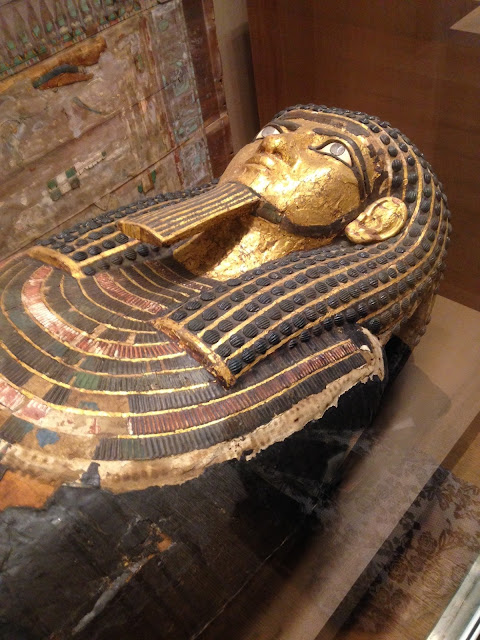Day 384 - Durer and Cranach the Elder
November 10, 2024
The theme of Gallery 607 is "The Reformation and the Age of Durer."At first I think that the curators are merely hopscotching between Italy and Northern Europe in consecutive galleries. But then, I realize that the basic organizing principle of the galleries is chronology: the Reformation is perhaps the most critical historical development of the first half of the 16th century ,and Albrecht Durer the era's leading artist, at least in the North. In any case, the wall signs do try to show the connections between the two major loci of artistic innovation, and Durer, with his extensive travels in Italy, personifies those connections.
In Durer's small (perhaps 24 inches high and 19 inches wide) 1505 painting entitled "Salvator Mundi", Christ's's body has what strikes me as an Italianate sense of weightiness and corporeality. Depicted as the world's savior, Christ raises two fingers of his right hand in blessing, while holding an orb symbolic of the world in his left palm. It's interesting to see the world depicted as round - a red ball, in fact - and even more interesting that the ball is vaguely reminiscent - to me. at least - of an apple, the symbolic representation of the sin from which Christ is delivering humanity. Christ is imagined as a gentle-faced man with reddish hair and a beard. (I watch bemused as a red-haiared, bearded young man visiting the gallery takes a picture of the painting.) Nothing Semitic about this Jesus.
Actually, as I look around, I see that many of the saints and other religious figures portrayed in these Northern paintings have reddish hair. presumably like the artists' Germans contemporaries. This strikes me as highly ironic because I'd always thought of red hair as a Jewish trait. I remember a memoir by a Polich Jew who survived the Holocaust, along with his sister, by living openly as Christians; the author noted that his sister dyed her reddish hair blond in order to "pass" more easily.
The introductory signage notes that artists of the period often included gruesome images in their religious paintings in order to capture viewers' attention.A painting by Lucas Cranach the Elder showing Saint Barbara about to be beheaded by her father for refusing to abandon her Christian faith.is a case in point. It's by far the largest painting in the room, and the saint is clad in a very elaborate bright red dress, but whatever the reasons are, it has the desired effect. As two young women enter the gallery, I hear one say, "Wow, look at that!" and then proceed to read a bit about the painting to her companion.
Even more gruesome is a 1530 or so Cranach painting of Judith holding the head of Holofernes. Measuring about 38 inches high and 28 inches high, it shows our heroine as a very elegant young woman, indeed, wearing a red hat with ostrich feathers, an elaborate dress with braid and beading, two gold collar necklaces inlaid with rubies, sapphires, and other precious gems, and multiple rings, Cranach has positioned Holofernes' foreshortened head to face us, so that we get a good view of the Philistine's just-severed neck; it looks something like coarsely ground meat. In death his eyes remain half-open under heavy lids; maybe he was anticipating getting well and truly laid when Judith dealt him the fatal blow.





Comments
Post a Comment